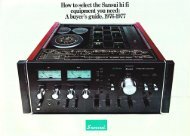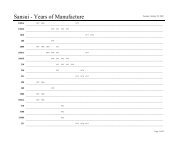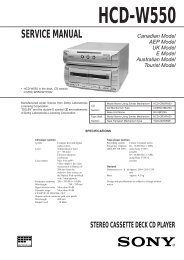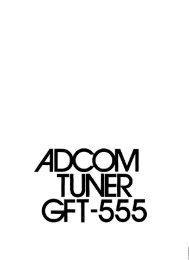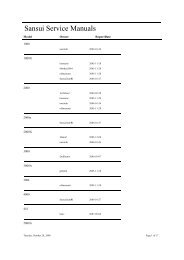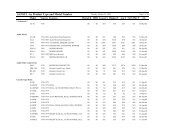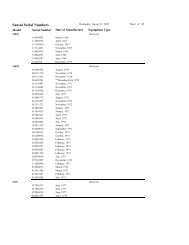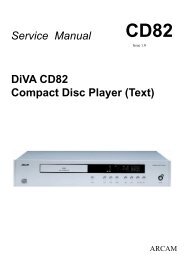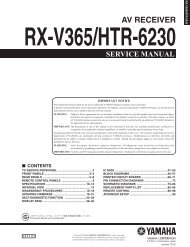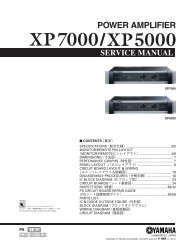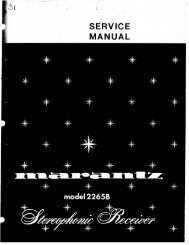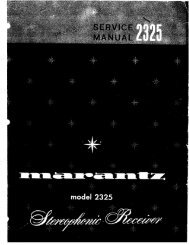Technical Information Service Instructions Manual turntable ...
Technical Information Service Instructions Manual turntable ...
Technical Information Service Instructions Manual turntable ...
You also want an ePaper? Increase the reach of your titles
YUMPU automatically turns print PDFs into web optimized ePapers that Google loves.
PE 2020<strong>Service</strong> <strong>Instructions</strong>Automatic <strong>turntable</strong><strong>Manual</strong> <strong>turntable</strong><strong>Technical</strong><strong>Information</strong>
Contents10aeasl161-17 Lubricating instructions14 Motor wiring diagram12+13 Pick-ups8 to 12 Adjusting instructions2 to 8 Functional description1 <strong>Technical</strong> specificationsPage
1Hi-Fl manual <strong>turntable</strong> and automatic <strong>turntable</strong>PE2020<strong>Technical</strong> specificationsMode of operation:Motor:Power consumption:Voltages and frequency.Speeds:Speed precisioncontrol:Turntable platter:WeightMaterialDiameterFlutter and wow(to DIN 45507):Rumble:related to a velocity of10cm/sec and 1,000cps(to DIN 45 500)Signal to noise:related to a velocity of10cm/sec and 1,000cps(to DIN 45500)Automatic <strong>turntable</strong><strong>Manual</strong> <strong>turntable</strong>Continuous <strong>turntable</strong>(repeat)Automatic record changerFour-pole induction motorSPM 4/15 with minimumstray field and centralsuspension with vibrationdampers8W110/22OVAC, 500r60 Hz162/3, 331/3 45, 78 rpm+7i3 °/lbs (32 kg)Zinc die casting1129/64” (291 mm)±0.1 %43db58dbPick-up arm length:Offset angle:Tangential trackingerror:with optimumadjustmentTone arm friction:Vertical tracking angle:Stylus pressure:Antiskating device:Antiskating correction:Suitable pick-upsPick-up weight:Chassis dimensionsInstallation dimensions:8/16” (208 mm)27°max. 1.8°0.07 p horizontal0.05 p verticalAdjustable for 8 recordsSteadily adjustable from0 to 6 pCoupled with stylus forceadjustmentFor differing stylus tipradii and for wet and dryplaybackFor all pick-ups with 1/2”standard mountingfacilities3 to 15 g14/32” by 12”(358 x 306 mm)Height above mountingboard with changerspindle55/44”(129 mm)Depth below mountingboard(80 mm)35/3z”
Functional descriptionheight with respect to the motor pulley (125).the precise speed ± 3 %, the idler wheel (61) mustpositioned exactly midway between + and —starting lever (197) through a brass switching rollerknob (8) provided below the speed selector knobThe speed is selected by means of a speed selec(6) is rigidly tor knob that united with the speedmoves the idler wheel support (83) to the correctfour <strong>turntable</strong> speeds are tapered. When adjustingknurled knob (8) has a red mark that must beControl levermaking this adjustment.Movement of the control lever (32) operates thesteps of the step pulley (125) corresponding to theSpeed controlselector cam (86). The speed selector cam (86)engage in the middle of the step pulley (125). TheSpeed precision control2Item No,.686182838586125EEKnurled knobIdler wheelIdler wheel supportShift fork subassemblyMotor pulleyIdler wheel heightThis adjustment is possible at any speed. A knurled(6) moves the idler wheel support (83). The fourwhenSpeed selector knobSpeed selector camDescriptionDrawspring for idler wheelthe descending portion of the cam track the pickfeed lever (150).The rising portion of the cam track of the controlcam (128) causes the feed lever (150) to lift thehorizontal movement of the feed lever (150). Downsame time, the pick-up arm (10) is frictionallyengaged and is then moved by the succeedingreleases the spring-loaded ratchet lever (192) whichwheel (61) is, at the same time, pressed against thecam of the spinning <strong>turntable</strong> (1) engages the adcontrol cam (128). Following one control operation,drive shaft (125) of the motor (126) and against theconnected to power and starts running. The idlervanced tip of the reject lever. The control cam (128)assembly (175). The starting lever (197) frees theinside rim of the <strong>turntable</strong>. The control lever (32)required for the following function,(176) that is mounted on the control lever bottomON/OFF switch (179) so that the motor (126) isis thus allowed to advance the reject lever. Theis thereby turned to such an extent that the pinionof the <strong>turntable</strong> meshes with the toothing of theall the control elements are moved to the positionPick-up arm movementpick-up arm (10) by means of the lift rod (57). At theup arm (10) is lowered and disengaged from the
39021153E1029F4632Item No.Description1 Cast metal <strong>turntable</strong> platter2 Turntable matting, outside ring3 Turntable matting, center ring5 Single-play spindle6 Speed selector knob8 Knurled knob9 Pick-up arm counterweight10 Pick-up head with pick-up arm tube21 Pick-up arm tracking weightadjustment knob29 Pick-up arm lock32 Control lever34 Feeler pin, long46 Slide carrier assembly56 Antiskating precision control knob153 Sensing pinD Stylus pressure zero adjustmentE Landing pointF Vertical tracking angleRecord droppingThe control cam (128) operates the drop lever (108)for the control of the automatic record spindle (4).As the push rod extension (96) is pulled down, thesupporting levers are retracted to release therecord which is thus dropped on the rotating <strong>turntable</strong>.Record size discriminationThe upper locating lever (42) as controlled by thecontrol cam (128) is moved inside the operatingrange of a feeler pin (34) rotating with the <strong>turntable</strong>.Depending on the size of the record, the feeler pin(34) is pressed down to a greater or smaller extent.The level of that pin controls the different distanceby which the locating lever (42) is restored for theinward movement of the pick-up arm (10) to itsposition above a 7” or 10” record. In the presenceof a 12” record, the upward movement of the sensing lever (154) as released by the control cam (128)is limited. The upper locating lever (42) is lockedduring its return movement and thus reduces theinward movement of the pick-up arm (10) to thestarting grooves of the 12 recordTrippingAs the pick-up arm (10) moves towards the centerof the record, the trip link (186) supported on thepick-up arm locator segment (184) impells thereject lever towards the <strong>turntable</strong> cam. After thestylus has reached a record diameter of about423/32” (120 mm), the reject lever touches the rotating cam for the first time and is repelled by thelatter until the lead-out groove with its higher pitchcauses the reject lever to be engaged by the camof the <strong>turntable</strong> (1), thus starting the control cam(128),
arm (10> returns to the pick-up arm rest (30> and isAfter the last record has been played, the pick-upAutomatic shut-offP Trip link guideT Upper locating leverF Vertical tracking angleE Landing pointA Locating lever eccentricD Pick-up arm tracking weightC Pick-up arm pivot screwB Sensing leverWasher forSensing pinUpper control leverknobPick-up arm lockUpper locating leverSlide carrier assemblyAntiskating precision control knob21 Pick-up arm tracking weight adjustment9 Pick-up arm counterweight8 Knurled knob10 Pick-up head with pick-up arm tube6 Speed selector knobIdler wheelFiltister headFillister headFillister headMotor pulley324266153466412565screw 4 x 8screw 3 x 5screw 4 x 8295662idler wheel61Item No. Description4of the pick-up arm. The centering portion of theoperating through a flexible pulling wire. actuatesthe cueing lever (159) and thus reduces the heightarea of the lead-in groove as in the case of changermatic <strong>turntable</strong> becomes a fully automatic singleplay<strong>turntable</strong>. Depending on the size of the reBy inserting the single-play spindle (5), the autoAutomatic single-playcord, the pick-up arm lands within the standardizedoperation. Moreover, the single-play spindle (5).single-play spindle rotates with the <strong>turntable</strong> (1)and thus avoids any friction at the record.connected from mains power.rim of the <strong>turntable</strong> and the record player is disdrawn from the motor pulley (125) and the insideoff track of the control cam (128). In the course of(129), the feed lever (150) is directed into the shutDue to the unchanged position of the stop switchis no longer operated by the shut-off lever (113).automatic record spindle (4). This has the effectthe shut-off procedure, the idler wheel (61) is withthat the stop switch (129) on the control cam (128)of records, the final shut-off is initiated inside thenot moved inward again. Because of the absence
5K Switch operating leverEE Idler wheel height203Muting switchShade&pole motorDrop leverPush-rod extensionSpeed selector camAdjusting armShut-off teyerControl camStop switchShorting camFeed leverRatchet leverStarting leverActuatorTrip linkCueing sleeveControl leverLower locating leverShift forkON/OFF swttchIdler wheel supportSwitching rollerPick-up arm locator segment83859619786128129163176184192132179186126135150175107181Item No. Description(128).provided at the outside edge of the control camextraneous noise in the loudspeaker. The mutingshorted against chassis to avoid disturbingDuring the changing cycle, the two channels areswitch (135) is operated by the shorting cam (132)Muting switchis maintained in its position and frees the cam trackto move to operating position; the stop switch (129)for the automatic final shut-off.out of engagement so that no additional recordsIf the upper control lever (32) is moved to stop”Stopthe actuator (203) brings the dropping mechanismare dropped. The shut-off lever (113) is not allowed(128) is interrupted and the pick-up arm (10) reproduced in the tooth rim by withdrawing the toothsegment (130). The movement of the control caming the horizontal pick-up arm movement, is movedaddition, the horrzontal switch (131), for suppressmains in its lifted position in frictional engagementposition to be lowered on the record.the above-mentioned operations ensue and, inabove the pick-up arm rest (30). From this position,the pick-up arm (10) can be manually moved to anyWhen moving the upper control lever (32) to “lift”,<strong>Manual</strong> single playto its respective operating position, while a gap is
Nthe tail end of the pick-up arm. The pick-up with theslide carrier must be incorporated for this adjustweight is elastically mounted to the pick-up armshocks and for absorbing vibrations, the countertube. The tracking behaviour of the pick-up armand thus the most important quality characteristictherefore, used a superfine twin ball-bearing, thebearing permitting the vertical movement of thecounterweight by radial movement of the latter onextreme importance for the antiskating device.Pick-up armment.The pick-up arm is balanced by means of theFor protecting the pick-up arm bearing againstsmall frictional forces of the pick-up arm are ofpick-up arm also consists of two superfine ballbearingswith a specially treated surface. The verybrasses of which have an extra-fine finish. Thehorizontal movement of the pick-up arm, we have,To assure the minimum possible friction for theof the pick-up arm is determined by its bearings.HH Eccentric, tracking weight56 Setting knob for antiskating precision46 Slide carrier assembly9Item No621D Zero-adjustmentPick-up arm counterweightPick-up arm tracking weight adjustmentknobDescriptioncontrol assemblyhigh degree of rigidity and minimizes resonanceChassis plate(08 mm) thick aluminium sheet is pressed upon theadhesive at a high temperature. This ensures a.06” (1.5 mm) steel plate, using a heat-sensitiveThe chassis plate is a laminated board. A 032”moving in on the record.ing operation. Since the feeler pin maintains itsof the unit.pressed down without allowing any permanentthe horizontal movements by means of a slipping(10) is connected to the operating mechanism forpick-up arm (10) is still locked, this cannot affectclutch (184). The pick-up arm lifting elements areWhen the unit is started without a record on theThe feeler pin (34) and the sensing lever (154)remain unaffected by a recording during the sensposition, the lower locating lever (151) is notis interfered with or if the unit is started while theIf the horizontal movement of the pick-up arm (10)Dependability featuresthe operation of the unit because the pick-up armresilient to permit the lifted pick-up arm (10) to bedeformation to interfere with the proper operation<strong>turntable</strong>, the pick-up arm (10) remains on its rest.repelled so that the pick-up arm is prevented from21 HH 0
71323222526Item No.13171822232526DescriptionSteel ball .04” (1 mm)Pivot screwCap for pivot screwBall race for pick-up arm bearingBearing bushing for pick-up armLower tapered bushingHexagon nut M 5.8 x 0.35RepeatAfter unlocking the changer spindle, the recordchanger will play a record and then repeat it overand over again. The next record will only bedropped after the changer spindle has been locked.Antiskating deviceSince the pick-up arm is not infinitely long andsince the pick-up head is arranged to form a certainangle with the pick-up arm tube, a small forceresults at the pick-up arm that tries to impeil thepick-up arm towards the center of the record. Thisskating force, as t is called, has the effect that thestylus exerts more pressure on the inside edgethan on the outside edge of the record groove.The skating force is a function of the stylus pressure, the stylus tip radius and the frictional conditions existing between the stylus and the record.The antiskating adjustment is made by adjustingthe stylus force, This is done by means of a springin axial alignment with the pick-up arm. The antiskatingdevice is controlled by means of a controlknob. Corrections are needed where differentstylus tip radii, elliptical needles or wet playbackare used.
Adjusting instructionsedge of the pin is in about the middle of the lowerWith the automatic <strong>turntable</strong> spindle inserted, theis visible in the slot (8) of the guide bushing (1 63)inserted record spindle. The amount of tone arm heightin the upper position of the feed lever and with(DD) of the feed lever (150) to about .04” (1 mm)Adjustthetone arm height by means of the guide postRemedy:Cause:Feed lever (150) is out of adjustmentfeed lever.Landing position of needle on record is not conAdjust the guide post (DD) at thestantAdjusting instructionsYY Pick-up arm locator segment28 Antiskating springW Lift rod hexagon nutV Antiskating device0 Locator segment eccentric pinDD Feed lever guide postZ Antiskating correctionCC Feed lever lugS Lift rodBB Muting switch retaining screwAA Friction of feed lever8R Shut-offiever lugU Pick-up arm bearing nutXYCueing leverFriction springItem No. Descriptionsegmentsegment (YY) in the middle of its cusp.Cause: Trip link is adjusted too close to rejectbearing must be seated on the pick-up arm locatorChanging cycle occurs too earlychecking the parts, make sure to see that the feedTone arm height with the pick-up arm unlocked. Whenslot (5). After the adjustment, the guide post (DD)must be locked by means of the locknut. Adjust thelever has a little play in its bearing. The frictionAdjusting tools: Screwdriver, hexagon wrench 5.5mmcovering of the friction spring (Y) of the frictionthe eccentric on the pick-up arm locatorleverbegin of the tripping cycle. The tripping cycle,position of the trip link (186) relative to the rejectstud can be adjusted by moving the trip link guidethe longitudinal slot until the trip link does nolonger change its position when the control cami. e. the rejection of the trip link should occur at aof the trip link and thus to advance and retard thesegment makes it possible to change the positiondiameter of 423/32” (120 mm) ± 13/64” (5 mm). Thescrewdrivercontinues to advance.(P) as required. Loosen the fastening screw in theThe eccentric pin (Q) on the pick-up arm locatorfirst place The trip link guide (P) can be moved inRemedy: Adjust trip link as required by means ofBegin of tripping cycleAdjusting tools: 5.5 mm hexagon wrench,pliers
90Item No.EGKLMNQDescriptionLanding pointShut-off leverActuatorEccentric, dropping assemblyLug, switch operating leverSteel cable adjusting screwFixing screw for control lever bottom assemblyEccentric, control lever bottom assemblyTrip link adjusting pin (eccentric)Remedy:Adjust eccentric (J) in such manner thatthe three small upper record fingers areflush with the outside diameter of the automatic record spindle.Dropping assemblyAdjust the push-rod extension for the recordspindle below the <strong>turntable</strong> bearing by means ofthe eccentric(J) so that the three small upper recordfingers are even with or lightly withdrawn behind theoutside diameter of the automatic record spindle.Needle fails to land at proper pointCause: Pick-up arm locator segment (YY) is outof adjustment with the adjustingeccentric (E)Remedy Turn the eccentric (E) clockwise to movethe needle landing point to the right,turn counter-clockwise to shift the landing point to the left.Landing pointA hole (E) in the chassis plate permits adjustmentof the needle landing point by turning the eccentric(E). Turn the eccentric clockwise to move the landing point towards the outside, turn it counterclockwise to move the landing point towards the inside.Adjusting tool: ScrewdriverRecords fail to drop from the spindleCause: Eccentric (J) at drop lever (108) out ofadjustmentAdjusting tool: 7 mm hexagon wrenchControl leverAfter loosening the retaining screws (M) in thecontrol lever bottom assembly the control lever(125) can be shifted to agree with the operatingsymbols on the chassis plate.Cueing leverAdjustment of the cueing lever (X) is via a flexiblewire (147) by means of the adjusting screw (L); thesingle-play spindle must be inserted for this purpose. The front edge of the reinforced portion ofthe cueing lever (X) must cover the lift rod (57) byone half. Make the adjustment by means of theadjusting screw (L).Adjusting tool: 5.5 mm hexagon wrench
10175NH203Item No.131175203NDescriptionHorizontal switchControl leverActuatorEccentric, control lever bottom assemblyPick-up arm fails to swing In after record hasbeen droppedCause: Lug (R) at shut-off lever bent out ofadjustment stop switch is notreversedRemedy: Bend lug (R) of shut-off lever as required(1)Actuator positionFollowing the lifting operation, the control lever isdeflected. When the control cam is turned, thehorizontal switch must be reversed by the bent lugof the actuator (H). As the cam turns, the anglepiece at the <strong>turntable</strong> bearing bracket must forcethe tooth segment to its outer position. To adjust,bend the angle piece as required, As the cyclecontinues, the tooth segment is moved to its insideposition by the bent lug (H) of the actuator (H).Adjust the position of the actuator by means of theeccentric (N) of the control lever bottom assembly.Adjusting tools: Hexagon wrench 7 mm, pliersPick-up arm too high or too lowCause: Lift rod out of adjustmentRemedy: Adjust pick-up arm lift rod by turning theadjusting nut (W)Adjusting the height of the pick-up armThe height of the pick-up arm is adjusted by meansof the pick-up arm lift rod. The adjusting nut can beturned up or down.The height of the pick-up arm above the chassisplate should be 2 13/16” (72 mm) with automaticspindle inserted. The reduced height of the pickuparm with single play spindle inserted follows automatically.Adjusting tools: 5.5 mm hexagon wrenchFeed leverAs the control Cdrrl (128) moves to position “LIFT”,the lug (CC) of the feed lever (150) must operatethe stop switch (129). if not, correct by bending thelug (CC) of the feed lever as required. Make thisadjustment with a record spindle in place.Adjusting tool: PliersFinal shut-offIn the positions “STOP” and “LIFT 1”, the shut-offlever (G) must be blocked by the actuator (H). Inthe normal position and in position “START”, theshut-off lever (G) must not be allowed to rub onthe actuator (H). Without a record spindle in place,the oblique lug of the shut-off lever must operatethe stop switch. Correct by bending at the shut-offlever as required.Adjusting tool: Pliers
11Item No151175ADescriptionLower locating leverControl leverEccentric, lower locating leverTurntable bearing bracketLoosen the retaining screws (64 and 66) and movethe bearing bracket as required to ensure easyengagement of the <strong>turntable</strong> pinion.Control lever cannot be moved to LIFTCause: Clearance between the lower locatinglever (151) and the bent portion of thecontrol lever bottom assembly (175) toosmallRemedy: Adjust the eccentric (A> at the lowerlocating lever,Position of tower locating leverThe clearance between the curved extension of thelower locating lever (151) and the control leverbottom assembly can be adjusted by means of theeccentric (A) at the left of the pivot. For this purpose, the control lever must be in the 1st lift position. The clearance should be between 20 and 40mils (0.5 to 1 mm).Adjusting tool: ScrewdriverSwitch operating leverIn the normal position of the control cam, the lever(K) must clear the ON/OFF switch about 20 mils(0.5 mm). When the control lever is moved to“START” or “LIFT”, the red lever of the ON/OFFswitch must be supported on the backstop. If thestarting lever (197) is engaged with the stop pawl,the switching roller (176) must clear the startinglever (197) 8 mils (0.2 mm) in any position of thecontrol lever.Adjusting tool: PliersPick-up arm has no frictionCause: Insufficient spring contact (Y) on pick-uparm locator segmentRemedy: Adjust the friction spring (Y)Pick-up arm frictionThe pick-up arm friction amounts to 15 to 20 p.when the pick-up arm s rafsed.Bending the spring supports (Y) permits changingthe position of the spring with respect to the pickup arm locator segment (YY). Care should be takento see that a clearance of 0.571” (14.5 mm> existsbetween the lower edge of the pick-up arm locatorsegment (YY) and the chassis board.Adjusting tools: Pliers, Force gauge 0-30 p.Operating noise heard during change cycleCause: Muting switch fails to make contact properlyRemedy: Adjust muting switchIn playback position of the record player, the twoshorting springs should clear the cçntact bars0.020” (0.5 mm). Loosen the retaining screws ofthe mutng switch and turn the muting switch untilthis clearance is obtained.Adjusting tool: Screwdriver
2726ameans of a stylus force gauge. An eccentric (HH) increpancy.the bracket permits compensating a possible disment knob with the red line to agree with the zeromark.Set the stylus force at 1 p and check byStylus forceclockwise as far as it will go. Replace the adjustknob (21) and turn the bearing sleeve (D) counterPull off the pick-up arm tracking weight adjustmentAttach the adjustment knob properly.red mark.Cause: Pick-up arm is not properly balanced.Adjustment knob fails to agree with theStylus force too high or too lowRemedy: Balance the pick-up armDrawspring for pick-up arm trackingweightAntiskating subassemblyAntiskating springSetting knob for antiskating precisionZero-positionEccentric, setting armEccentric, stylus forceEccentric, adjusting linkcontrol subassemblyAntiskating adjusting linkknob21 Pick-up arm tracking weight adjustmentZHHDV28165562726aItem No. Description28z12ing angle is possible in the pick-up head.Since the master recordings are cut at an angle ofreproducing a recording are at their lowest whenthe needle moves in the sound grooves at the sameangle of 15D. The adjustment of the vertical track15, the inherent distortions of the pick-up whenVertical tracking angle adjustmentsensing pin mustnotbeallowed to rub on the outsideedge of the <strong>turntable</strong>, when in uppermost position.lever hole. Without a record on the <strong>turntable</strong>, theIf necessary, adjust in the middle of the sensingIn the normal position of the record player, theSensing leversensing pin (153) must be in the center of the hole,(165).eccentric pin (Z) of the antiskating adjusting linkof the skating force is found to exist, the springwith the pivot point of the pick-up irr1 If, whenthe eccentric below the chassis plate in suchmanner that the receiving point of the springinesupadjusting the stylus pressure, an overcompensationMove the adjusting knob torJestyliiaforce to roAntiskating deviceposition. Then, adjust the setting arm by means oflength tolerance can be corrected by means of theAdjusting tools: Screwdriver, stylus force gauge 0-6 pHH21D
—- right-hand13NOTE: The numbers indicated refer to the operating instructions,Pick-up headWhen mounting pick-ups on the pick-up head (7) itmust be kept in mind that the playback needle mustbe in an accurately defined geometric position. Themounting gauge (26) supplied with <strong>turntable</strong>swithout pick-up makes it possible to check the pickup for correct position.Mounting pick-ups on the pick-up head(only applicable to units without pick-up)To mount a pick-up, please proceed as follows:1) Turn the rotary knob for the tracking angle adjustment (6) to position I Then mount the pickup by means of the screws (22) and spacerrollers included in the accessories so on thepick-up retaining plate (27) that the needle of thepick-up is exactly in the center of the two intersecting lines of the mounting gauge (26) thathas been slipped over the guide grooves of thepick-up head. In this position, the needle shouldjust touch the inside surface of the mountinggauge. Choose the size of the screws and of thespacer rollers as required for the pick-up.2) Loosen the retaining screws (22) of the pick-upup once more a little and move the pick-up sidewardsuntil the needle agrees with the longitudinal line. Tighten the retaining screws again.3) For the longitudinal movement of the pick-up,loosen the screw (24) and shift the pick-up untilthe needle coincides exactly with the cross-lineof the two intersecting lines on the mountinggauge (26). Tighten the screw again.The pick-up is now accurately adjusted and youhave the guarantee that the needle will always landin the starting groove of the record in automaticoperation.The slide-in pick-up head is equipped with a 5-poleconnector. Both the two chassis connections of thechannels and also the grounds of the pick-up canbe separatelyconnected, In the case of a regularmodel, I, e. when the grounds in the pick-up headis connected to a chassis pin the leads (25) shouldbe connected as followsredwhtegreenbluechanneleft-hand channelright-hand ground= left-hand groundTracking checkTo prevent geometric playback errors, the horizontal ditance of the needle tip must also be correctlyadjusted. In the PE 2020 pick-up arm this is thecase when the pick-up needle coincides with theintersecting lines of the mounting gauge. If thepick-up is installed by the customer, adjustment tothe optimum conditions is possible.
IIISeries connectionParallel connectionVoltage selector50 to 60 cycles per second can be effected by excally switched to 110 or 220 volts through thepulley exactly in the middle. Care should be taken(61) must contact the individual steps of the motorThe motor pulley (125) is held in place by a grubconnected in parallel. The windings are automati60Hzarmature shaft can be changed. The idler wheelIn the case of 110 volts, the two windings are to beconnecting the two associated windings in series.voltage selector.Replacing the 50 Hz motor pulley with one ofisexactly in the middle of the range. A change fromchanging the motor pulley.Air gap:screw (124). The position of the motor pulley on theIn the case of 220 volts, connect the motor byWiring diagram for motor SPM 4/15to see that the red mark of the precision controlIdle speed (rpm):Maximum output (W):at 250 C:Resistance per windingWire thickness:Pull-out torque (pcm) at (rpm):50 Hz<strong>Technical</strong> specificationsCurrent drain (mA):Apparent power (VA):Alternating Current Motor SPM 4/15, 110/220 V,Power consumption (W):Turns per winding:Exterior dimensions:Rotor diameter:Stack height:14000.010” (0,25 mm)19/32” (15 mm)20/64” (335 mm)Starting torque (pcm):(installation depth)(74 x 74 x 74 mm)229/32” x 229/32” X229/32”125 ohms0.15 Cu! DIN 464355712.5100 (1100)641.171460117V 60Hz220V 50Hz11OV Hz11OV/220V 50HzMainL witch.MainsMains LwitchLIJccfl-J 1 FJci)ci)I I14
IsTV 212 © 0I11oV©TV 212sw11OVswignrt11O/22OV’Wiring Diagramof Pre-amplifier TV 212Exchanging the pick-up armThe pick-up arm is to be exchanged completelytogether with the bearing framqjj4). After removing the ca 18 turn back the bearing screw (17un i pick-up arm can be lifted out of the a Ibearing. Be remyjag the pick-up arm, unsolderthe pick-u1ad from the mgh and unre4e—thFT fl’st lus ressure 26from e antiskating subassembly by means of abent wire. The drawspring for the stylus pressure(26a) is hooked to the antiskating subassembly bettWThe chassis plate in the pick-up arm bracket.To proj acssttiiing, adjLhestylus presure by means of the adjustment knobinstalling the p ck-up arm. take care to seethat the seven steel balls in the bearing frame (14)are embedded in Apex grease. Minimum possiblefriction of the bearing must be assured A specialscrewdriver permits adjustment of the bearingscrew (17) through the cap.When exchanging the pick-up arm with the complete bearing, including the antiskating device, takecare to see that the ball races for the pick-up armbearing (22) are clean, free from dust and providedwith Abrol oil when they are installed. The frictionof this bearing must be adjusted with particularcare. Tighten the hexagon nut58mm(26) by meansof a special wrench until the desired bearing friction is obtained. When hooking back the antiskatingspring (28) make certain that it is replaced in thecorrect position and without any change.Exchanging the cueing lever cableTo exchange the flexible cable (147) the entirecueing lever subassembly (159) must be removed.When replacing the lever, take care to see that thisis done in the correct position (see page 9).Exchanging the lift rodThe od 57 is only accessible after the ick-up,.rnj_ith the entire racket has been removeRef illabsolutely necessary. Take care to see that only aminimum quantity of silicone grease is applied tothe lift rod. Also make sure that the drawspring (58)is hooked back to the lift rod (57)Exchanging the control camAfter loosening the retaining screws (64 66) forthe turntab e bearing and taking out the nut (133)the control cam can be lifted up and out, It shouldbe noted that for this purpose the feed lever (150)and the actuator (203) must be disengaged fromthe control cam.
El‘tern No. cam track, except for tooth rim 125186 bushing 150197151 A Feed lever sliding face for guide76 o Turntable bearing with ball-bearing 97-99154 A Idler wheel bearingAdjusting arm slot 81Knurled knob bearing 8— o Lift rodLI Feed lever bearingLI Cueing lever bearing192 0 Lift rod friction face 57o Control cam bearing, sliding faces andfriction 42hole of chassis plateO Bearing plate for feed lever 167O Ratchet lever bearing in elongatedcorrection —O Control knob for antiskatingo Horizontal bearing 13o Antiskating adjusting link bearing 165o Upper locating lever bearing andEl guide bushingEl Lift rod —22-26 0 Shift rod with guide 105o Actuator slot 2038690 levers for starting lever pinO Sliding faces of ratchet and startingO Shut-off lever/drop lever bearing 113/108Upper control lever assembly bearing 32o Drop lever eccentric 108O Push rod extension 96ingroundbearingsurface 57and cam trackWhen the record changer is assembled, all slidingtion. The following oils and greases should be usedtrack with ball ratchet arrangementRatchet lever pivot bearingSpeed selector cam bearing and camfor this purpose:Idler wheel support pivotIdler wheel arm bearingLi = Abrol oil 0 = Apex greaseA = MolykoteLubricating <strong>Instructions</strong>and bearing points are sufficiently packed withlubricants, Relubrication of these points is requiredafter about 1000 operating hours in normal opera(lubricate thriftily>Starting lever bearingSensing lever bearingActuator bearing 203Lock pawl bearing 201Vertical pick-up arm bearingLower locating lever bearingTrip link bearing at eccentric pinflflElEl0ElElElElpointsLubricatingthe range of theoil Apex grease IS. Molycote16
17Abrol oil Apex grease ‘MoIycoteIt is important that no oil or grease be allowed toget to the friction faces of the idler wheel, of the<strong>turntable</strong> and the drive pulley. Lubricants otherthan those recommended by us are liable to undergo chemical decomposition. We would, therefore,advise you to use only the lubricants recommendedby us.
9o6l9Lt71ELLI0I-—I66SI -99LL9 9999 t9E9 9°i6E-j9E- —i1 :—99:-9tEE81 -LI81
ornamentalcenter19Item No. Part No, Description1 15 0632 0 Turntable platter2 15 3153 0 Turntable matting - ring3 15 3154-0 Turntable matting - ringAutomatic record spindle 7 mm5 15 1512 Single play spindle6 15-1540 0 Speed selector knob assembly7 15 0606 0 Chassis board assembly8 15 3023 0 Knurled knob,±apeed selector knob for1i1’peed control)9 15 1519 0 Pick-up arm counterweight10 15 0633 0 Pick-up head with pick-up arm assembly andshield for bearing frame11 15 3091 0 Fixing clamp12 15 3098 0 Holding plate13 798 010 Steel ball 1mm14 15 1521 0 Bearing frame15 15 3089 0 Shield for bearing frame16 7930680 Fillister head screw 2,9x1617 15 3107 0 Bearing screw18 14 3186 0 Cap for bearing screw19 15 0622 0 Pick-up arm base20 791 066 Countersunk screw21 15 1532 0 Pick-up arm tracking weight adjustment knob22 798 103 Ball race (ball retainer) for pick-up arm bearing23 15 3034 0 Bearing bushing for pick-up arm24 1530380 Hexagon nut M 13 x 0,525 15 3037 0 Lower tapered bushing26 15 3039 0 Hexagon nut M 5,8 xO,3526a 15 3105 0 Draw spring for pick-up arm tracking weight27 15 0624 0 Antiskating subassembly28 15 3126 0 Antiskating spring29 15 1538 0 Pick-up arm lock30 15 1539 0 Pick-up arm rest subassembly31 790 618 Holding sleeve 1,5 x 532 15 0628 0 Upper control lever assembly33 14 3164 0 Latch (Chassis securing)34 15 3031 0 Feeler pin - long35 00 350 0 Compression spring36 1430340 Guide disk37 794_708 “C’ clip 2,338 01 464 0 Washer 12X4X1,239 00 358 0 Compression spring40 00 366 0 Draw spring for upper locating lever41 143079 Securing cip42 14 1520 0 Upper ocating ever43 14 3074 0 Pivot pin44 01 4650 WasherBX32Xl,53 791 276 Cy drical screw M 2,6x3 546 15 0620 0 Slide carrier assembly without artridge47 15 3084 0 Fixing plate48 794 708 “C’ clip 2,349 14 3085 0 Pivot pin for sensing lever50 791 624 Fillister head screw AM 3X551 15 3076 0 Guide roller (Friction roll)52 15 3075 0 Trip link guide53 794 706 “C’ clip 1.954 01 463 0 Washer 10X2,5X0,555 794 167 Hexagon nut M 3,556 15 1527 9 Setting knob for antiskating precisioncontrol subassembly1506170 Liftrod00 382 0 Draw spring for lift rod
17717417617568691051061041031021011009997989695-909493—--888992918784807372717020107 109 111 112 113 114108 110150- -149148147146171I ---170127 145144 —143142125121-124-123--122137119-—136117116-‘ 77-—-:>-115118767578120164:j;-—135134162165161160163-159166205204203-202201200199198197196195- —194193192191190189188187186185184183181180182179178173172
21Item No, Part No. Description59 791 637 Fillister head screw AM 3X1560 79±48 Fillister head screw AM 3X2862 01 2Q’ Washer for idler wheel63 792402 Fillister head screw AM 3X5 for motor suspension64 791 672 Fillister head screw AM 4x864a 794 618 Washer65 791 624 Fillister head screw AM 3X566 791 672 Fillister head screw AM 4X86$a 794 618 Washer67 791 622 Fillister head screw AM 3X468 15 3013 0 Suspension spring * blue69 14 3058 0 Guide pin70 15 3024 0 Spring cup71 15 1506 0 Lower locating lever assembly72 15 3012 0 Suspension spring - green73 794 722 “C” clip 974 01 460 0 Washer75 794 708 “C” clip 2,376 14 1516 0 Idler wheel arm subassembly77 01 3150 Washer78 794 708 “C” clip 2,379 15 3021 0 Pivot pin for idler wheel arm80 794 716 “C” clip 681 15 3022 0 Adjusting arm82 00 378 0 Draw spring83 15 0600 0 Idler wheel support assembly84 00 377 0 Compression spring85 15 1503 0 Shift fork86 15 1505 0 Speed selector cam subassembly87 00 347 0 Com ression spring88 798045 a 4mm89 794 710 “C” clip 3,290 1430470 Holding bracket91 794 710 “C” clip 3,292 791 622 Fillister head screw AM 3X493 15 3160 0 Angle bracket94 794 165 Hexagon nut M 395 791 622 Fillister head screw AM 3X496 15 3060 0 Push red extension97 01 497 0 Upper washer98 798 102 Ball retainer99 01 496 0 Lower washer100 01 306 0 Cushioning washer101 15 0615 0 Turntable bearing bracket assembly102 794708 “Cctip2,3103 15 1516 0 Gu de bracket subassembly1 4 793 070 F astcr head screw B 2 9X6 5105 15 3059 0 Shift rod106 794 708 “C” clip 2,3I 00 365 Tors c n sp ng for drop levcr-1J8 14 1537 0 prop lever subassembly109 794 708 ‘C” clip 2,3110 14 3150 0 Roller for drop lever111 794313 Washer 3,2112 00 366 0 Draw spring for locating lever113 14 1538 1 Shut-off lever subassembly114 00 363 0 Draw spring for stop pawl115 05 3100 Chassissuspensioncushion116 04 439 0 Springcup117 795 934 Cable holder118 795 929 Fixing clamp119 794313 Washer 3,2120 791 624 Fillister head screw AM 3X5121 01 316 0 Insulating clamp
22Item No.Part No.Description122123124125125a1261271282913013113213313413513613713813914014114214314414514614714814915015115215315415515615715815916016116216316416516616716816917017117217317417517617717817918018118201 201 0794 165790 365151507015 1508014 0702 014 3070 015 0616 049—Q14 1528 014 1530 01431190794 16714 3190014 06220794 313791 62815 3058 0794 16915 3055 015 30730791 30614 3085 079470800 36701431590746 400795 394794 16515 1518 014 15190794 70815 15370150626000 357001 491 001 490 0794 71615 1515000 3480794 708794 270151514015 313401515330794 7121530700I4 fUb794 4311430680794 169791 62400 3600791 30614 1524 01430980794 702791 624797 001 31530140795 8011515360Terminal plateHexagon nut M 3Grub screw M 35x5Motor pulley 50 HzMotor pulley 60 HzShaded-pole motor SPM 4-15 withmotor suspensionBearing pin for control camControl cam assemblyStcp’itchTooth segmentHorizontal switchShorting camHexagon nut M 3,5Seating bracketShort-ci rcu iterWasher 3,2 for short-circuiterFillister head screw AM 3X8Threaded sleeveHexagon nut M 4Protective sleeveSupport bracketCylindrical screw AM 3X6Pivot pin for feed lever“C” clip 2,3Torsion spring for feed leverGuide screw,for feed leverFlexible wireTube rivetHexagon nut M 3Feed lever assemblyLower locating lever“C” clip 2,3Sensing pin subassemblySensing lever assemblyDraw spring for sensing leverWasherSpring cup“C” clip 6Cueing lever subassemblyDraw spring“C” clip 2,3Lock nutCueing sleeve subassemblyTorsion springAnti-skating adjustC’ clip 4Bearing plate for feed leverU CHp LiSpring washer A 5Compression sleeveHexagon nut M 4Fillister head screw M 3X5Draw springCylindrical screw 3X6Control lever bottom assemblySwitching roller‘C’ chp 1,2Fillister head screw AM 3X5ON/OFF switchSuspension springSoldering terminalProtection angle bracket
23Item No. Part No, Description183 791 622 Fillister head screw 3X4184 15 1517 0 Tonearm locator segm.ent185 791 304 Cylindrical screw AM 3X5186 1530740 Trip link187 014840 Paper washer188 794 704 “C” clip 1.5189 795 504 Tube rivet190 00 361 1 Torsion spring for ratchet lever191 794 710 “C” clip 3,2192 14 1525 0 Ratchet lever subassembly193 00 369 0 Draw spring194 14 3226 0 Flat switch spring195 794 710 “C” clip 3,2196 00 362 0 Torsion spring for starting lever197 14 1532 2 Starting lever subassembly198 794 710 “C” clip 3,2199 794 319 Washer 9X42X1200 10 505 0 Lock segment201 14 3135 0 Lock pawl202 00 364 0 Draw spring for lock pawl203 14 1534 1 Actuator subassembly204 794319 Washer 9X4,2X1205 794 710 “C” clip 3,2
3LJ3to the connector of the automatic <strong>turntable</strong>e) Connect the mains cord (3) of the preamplifierthe outside and secure the pull-relief again.d) Run the pickup cable (2) of the preamplifier topickup iack (1).the automatic <strong>turntable</strong>, wrap up and plug into thec) Remove the pickup cable from the pulhrelief atcorner of the frame or mounting board.b) Place the preamplifier into the lefthand backand slide the latches towards the center.screws of the two locking latches below thechassis plate through the hole in the <strong>turntable</strong>mounting board. For this purpose, loosen thea) Remove the playback unit from the frame orproceed as follows:case of the PE 720 and PE 2020 playback unitsTV 212 G is easy and requires no soldering. In thenor the connected power amplifier have an integralpreamplifier. Subsequent installation of thewith a magnetic pick-up if neither the playback unitMounting instructionsThe TV 212 G Preamplifier is needed in conjunction34Resistor2Five-pin plugMains connecting cord241 21Five-pole jackItem NoDescriptionThis change should, however, be made by aplug.from the mains together with the automatic <strong>turntable</strong>18 kilohm/3 W resistors supplied with the preamp.in parallel with a I1OV winding.the ON/OFF switch, the preamplifier is connectedthe built-in resistor (4) must be replaced with thespecialist.Regardless of the mains voltage, the connector isconnector for the connection of the preamplifier,connect it to the terminals of the voltage selectorconnected direct to the mains if a mains plug isThe preamplifier is now switched on and off bymeans oftheON!OFFswitch of the automatic <strong>turntable</strong>,but can only be switched off by pulling the mainsalways connected to 110 V.or to terminals 2+3 of the terminal board. Throughprovided at the end of the mains cord (3), If thismethod is used, it should be kept in mind that thepreamplifier will not be automatically disconnectedwith it. PE frames incorporate suitable mountingframe or housing, using the screws suppliedholes.2f) Secure the preamplifier to the bottom of theIn the case of automatic <strong>turntable</strong>s having no separateIf the preamplifier is to be operated on 220 volts,If necessary, the TV 212 G preamplifier can also be
AI’IIC 48/C21co25Channel separationOperating voltage:Noise:Distortion at 1000 cps:at 1000 cps:Dimensions:Power consumption:Gain at 1000 cps:Weight:Approx. 1 lb. (500 g)(97 x 98 x 52 mm>3/i” x 3/64” x 2/64”1.5 VA110 V (220 V by ex60db>65db34dbbass range to suppressresponse deviation in thewith DIN 45547 with aEqualized in accordanceslight frequencyrumblechanging the resistor)Twin pick-up cableMains connecting cordHousing subassemblyFillister head screw M 3 x 25Cylindrical head plate screwHousing coverHolding blockSpacing rollerSpacer postStudConnecting cordFive-pole jackCapAmplifier boardFillister head screw AM 3 x 47972500Preamplifier TV 212Cable sleeveWasher 32Resistor 18 kilohms, 3 W620740621550623190034970034910023880795936023890054290Mains transformerWire-wound resistor 8.2 kilohmsRectifier B 30 C 250Tantalum capacitor 15 /2F 3/4 VTantalum capacitor 3 F 6/8 VElectrolytic capacitor 100 zF 35 V791 622791646792817623200794858033881Frequency response: Cat. No. Descriptiontechnical spezificatlons TV 212 Spare parts list TV 212623210TV 212j Equalizer-PreamplifierE0107100,MRill0.1llii7
KU/1126/968 Subject to change Printed in GermanyPerpetuum-Ebner 7742 St. Georgen/SchwarzwaldPerpetuum—Ebner
<strong>Technical</strong>I nformationSupplement<strong>Service</strong> <strong>Instructions</strong><strong>Manual</strong> TurntableAutomatic TurntablePE 2020for ModelPE 2020 L
70179173176178174i77694172175106X105X104X103X102101 —10099989796-84--8382818072737168-I-075—--107 109 111108 110127120—a119—-’118—117z116-112 113 114154151-153-134-—165------—- -164205204zQp— -199198-19?196195194--193a—— 188s—- —187--—— 186--185184183182181180
-32 a- j32c32 ci‘° IiiCIISI;/——32S32f— —32f- -163g163d163e—;—--:163 h•- 163b— “163co =781506060153023086 151505090 143047093 1531600128 1506160163 1515140192 1415250201 1415330203 1415340103 to 106138 to 140147 + 148159 to 1617a 15060618a 16300908b 01513 032a 153210032b 153209032c 1530850Changed parts of PE 2020 LItem No. Part No, DescriptionXChassis board assemblyKnurled knobSpeed selector camsubassemblyHolding bracketStiffening bracketControl cam assemblyCueing sleevesubassemblyRatchet lever subassemblyLock pawlActuator subassemblyParts missing in PE 2020 LX = missingX missingX = missingX missingNew parts in PE 2020 LChassis board assemblySetting leverWasherKnob for lift leierLift leverPivot pin for lift lever32d 00387 032 e 79470832f 794557Lift torsion springCirclip 2,3Retainer for shaftswithout groove, 2,569 a 01 509 0 2 Spacers86 a 1615030 Speed selector camsubassembly90 a 1430470 Holding bracket(3 positions)93 a 1531600 Stiffening bracket93 b 7972506 Connector93 c 791 637 Fillister head screw 3X 15128 a 1506161 Control cam assembly161 a 794313 3 Washers for lift rod163 a 1515550 Cueing sleeve163 b163 c163 d163 e163 f163 g163 h163 i163192 a201 a203 a79455815321801531170subassemblyRetainerRetain rg spr ngFriction sleeve00388 0 Compression spring forcueing sleeve1532190 Retaining sleeve1515560 Push rod for liftsubassembly794557 Retainer for shafts7947081532160151551015155001515490without groove, 2,5Circlip 2,3Lift bracketRatchet leverLock pawl subassemblyActuator subassembly
PPETUJt-EB1RJFK:RG PAGE 1/1EBNER <strong>Technical</strong> Bulletin number 5 dated July 18, 1969.NOTE: <strong>Technical</strong> Bulletin number 7002 supersedes PERPETUUMpart number 15—1505 for the model PE 2020 and 16—1503 for thewill expose the speed selector cam to possible damage.metal bracket assembly. Fa1ure to observe this precautionmodels PE 2018, PE 2038 and PE 2040, will be protected by aWhen placed in this positiun, the plastic speed selector cam,wood base, the speed selector knob should he set to the 78 rpmthe PERPETUUM-EBNER Owner’s <strong>Manual</strong>, or when installed on aoriginal packing materials, as outlined in the instruction ofposition.When transporting the PERPETUUM-EBNER <strong>turntable</strong>, either in theMODELS: PE 2018, PE 202Q, PE 2038, PE 2040SUBJECT: SPEED CONTROL CAMTECHNICAL BULLET IN NUMBER 7002 DATE: MAY 1, 1970!(echnicaI BulletinD
PERPETUUM-E BNERJFK:RG PAGE 1/3leaf spring remains parallel to the tonearm locator segment “YY”Y 2, straight down the same amount so the plastic pin in theIncrease the friction between the leaf spring “Y” and thethe feed lever assembly (150). Bend slightly both arms Y 1,tonearm locator segment “YY” by bending the two (2) arms offifteen (15) and thirty—five (35) grains.force gauge from zero (0) to fifty (50) grams and read betweenCycle the <strong>turntable</strong> to the “cue up” position and measure thetonearm lateral friction force. It should be measured with athe tilted record,friction force to carry the tonearm out from under the weight ofPE <strong>turntable</strong>s are adjusted at the factory with sufficient cyclingonly one out of several thousand plays but, nevertheless, alland possibly damage the stylus. This phenomena may occur inwill release the record, causing it to drop on top of the tonearrnthe record may impede the cycling of the tonearm. The spindleIf the record tilts down over the area traversed by the tonearm,elevator type spindle.being thicker and heavier in some portion. These records maynot lie horizontal when used on automatic <strong>turntable</strong>s using ancenter holes or may be unevenly pressed, resulting in a recordrecords have improperly formed, worn, or eccentric (off center)In testswithvarious records, it has been found that someMODELS: PE 2018; PE 2020 PE 2O3 PE 2040SUBJECT :_IRREGULIRECORDSTECHNICAL BULLETIN NUMBER 003 DATE: MAY 1., 1970MARKETING Ijechnica! BulletinD
t1txjIIIm00a0crCwIU)CDC)010GDrt00tz:I01 00CD‘10IC)0C!)HIM0wGDtIt\)00tI0L’ILD0
PERPETUUM-EBNERJFK:RG PAGE 3/3EBNER <strong>Technical</strong> Bulletin number 6 dated December 20, 1963.NOTE: <strong>Technical</strong> Bulletin number 7003 supersedes PERPETUUM—made only with the automatic spindle.NOTE: All measurements of the tonearm friction should bethe feed lever assembly arms? the tonearm friction, in the cue upobserved.assembly were adjusted unequally and the plastic pin is notof its movement over the record and setdown point, should beposition, should be measured and the tonearm action, at the heightsetdown point exceeds 1 mm, the two arms of the feed levera slight “kick” to the outside and lower straight down onto thepoint, prior to setdown on the record, the tonearm should exhibitrecord. If the tonearm wavers before lowering or the change inically at 33 1/3 rpm. Observe th tonearm action; at the highestparallel to the locator segment “YY”. After each adjustment ofPlace a record on the <strong>turntable</strong> and cycle the <strong>turntable</strong> automateach adjustment.tonearm friction (fifteen (15) to thirty—five (35) grains) afterwell as disturb adjustments of other functions. Measure theat point “DD”. This will alter the height of the tonearm asDo not attempt to increase the friction by making the adjustmentMODELS: PE 2018 PE 2020; PE 2038; PE_2040SUBJECT: IRREGULAR RECORDSTECHNICAL BULLETIN NUMBER 7003 DATE: MAY l 1970MARKETING @chnical Bulletin
PERPETtJUM-E BNERJFK:RG PAGE 1/1EBNER <strong>Technical</strong> Bulletin number 7 dated June 9, 1969,NOTE: <strong>Technical</strong> Bulletin number 7004 supersedes PERPETUUM—+ 3,50 = 3,7stylus size listed on the chart.setting added to the anti—skating setting of the next largerin stylus size divided by the difference in anti—skatinggrams, the anti-skating setting would be 3.7, or the differenceFor a spherical stylus of 0.8 rail, at a stylus force of 1.5EXAMPLE: SPHERICAL STYLI ONLYlisted. At 1 gram, the anti—skating setting would be 6.75and 6.75 for the stylus sizes 0.2x0.7 rail and 0.4x0.7 rail2 grams, the anti-skating setting would be 7.75, or one halfthe (½) difference between the anti-skating settings of 8.75For an elliptical stylus of 0.2x0.9 mu, at a stylus force ofminus 5.75 equals 1.00 and one half (½) of 1.00 plus 5.75equals 6.25.EXAMPLE: ELLIPTICAL STYLI ONLYapproximate setting may be obtained by extrapolation.on the anti—skating chart of the PE Owner’s <strong>Manual</strong>s, theFor stylus sizes, elliptical and spherical, that are not listedMODELS: PE 2018, PE 2020, PE 2038 PE 2040SUBJECT: ANTI-SKATING CHARTTECHNICAL BULLETIN NUMBER 7004DATE: MAY 1 1970ELPA MARKETING ech&caI BuIIetinD
PERPETUUM-EBNERJFK:RG PAGE 1/1between the brass suspension cup and the wood base.is available at no charge. The plastic washers are to beinstalled, as many as may be required to level the chassis,To correct this problem, a kit consisting of plastic washers(By 18, BV 20 or LZ 2020).this tolerance, may be apparent in the form of a tilt in thechassis mounting spring suspension. Evidence of extremes, ofchassis plate when the <strong>turntable</strong> is installed on the wood baseThe PERPETUUM—EBNER factory maintains a tolerance of 3mm in theMODELS: PE 2018, PE 202O PE 2038, PE 2040SUBJECT: CHASS IS TILTTECHNICAL BULLETIN NUMBER 7005 DATE MAY l l 970MARKETING (echnicaI Bulletin
PERPETUUM-EBNERPAGE 1/2be removed and the holes enlarged slightly with a small round file.the necessary repositioning. If there is not, the two screws shouldSufficient play should exist in the chassis holes to accomplishassembly is secured to the chassis via two screws (items 64 and 66),to the left of the <strong>turntable</strong> chassis. The bearing bracketThe complete bearing bracket assembly (item 101) must be shiftedonce per revolution.of the main cam assembly and the gear on the <strong>turntable</strong> platterThe cause of the thumping is the partial engagement of the teethspeakers at normal listening level.stylus on quiet groove of record and listen throughdirectly from <strong>turntable</strong> in a quiet room or placestart), and listen to once per revolution thumpc. <strong>Manual</strong> start (move command control lever to left tounaided.b. Automatic stop, let <strong>turntable</strong> platter come to halta. Automatic start with either automatic or single playspindle.may occur after the following sequence of three operations:A thumping sound once per revolution of the <strong>turntable</strong> platterMODELS: PE-2035, PE-2038,PE-2040SUBJECT: THUMPING ONCE PER REVOLUTION DATE: SEPTEMBER 2, 1971TECHNICAL BULLETIN NUMBER 7007-ELPA MARKETING
cmHrntxlC CtEltEltElrnmC’,rnC’,IiC-)0tnIs)CUitjf%.)CL)C)0zC)rnmlIs)C0t-4HmiCI)tiltxlIs)
i.rj&P*:4’?
MARKETINGPERPETUUM- EBNERTECHNICAL BULLETIN NUMBER 7007SUBJECT: THUMPING ONCE PER REVOLUTION DATE: SEPTEMBER 2, 1971MODELS:PE-2035, PE-2038, PE-2040A thumping sound once per revolution of the <strong>turntable</strong>may occur the following sequence of three operations:afterplattera. Automaticspindle.startwitheitherautomatic or single playb. Automatic stop,unaided.let<strong>turntable</strong>plattercometo haltc. <strong>Manual</strong> (move command control lever to toand to once per revolution thumpfrom <strong>turntable</strong> in a quiet room or placestylus on quiet groove of record and throughspeakers at normalstart),directlystartlistenlistening level.listenleftThe cause of the thumping is the engagement of the teethof the main cam assembly and the gear on the <strong>turntable</strong>once per revolution.partialplatterThe complete bearing bracket assembly (item 101) must be shiftedto the of the <strong>turntable</strong> chassis. The bearing bracketassembly is secured to the chassis via two screws (items 64 and 66).play should in the chassis holes to accomplishthe necessary repositioning. there is not, the two screws shouldbe removed and the holes enlarged with a small roundleftSufficientexistIfslightlyfile,PAGE 1/2
PERPETUUN- EBERPAGE 1/2indicating the cam has not fully completed the cycle. Removerevolution.completion of each cycle. However, after the “stop” operationthe cam cycle may be incomplete. A slight pressure on thelock pawl, where the spring connects, will produce a “click”the coils (approximately 7 coils). Bend the last coil flat<strong>Technical</strong> Bulletin No. 7007 and check for thumping once perFollow operational sequences a, b and c as described in PEthe lock pawl spring (202) and cut off approximately 1/3 ofto form a hook and replace on the lock pawl and fixed post.The lock pawl (201) plastic tip secures the main cam afterthe <strong>turntable</strong> platter gear.revolution thumping as the main cam gear partially engages9/2/71, sections a,b and c, to identify the once perRefer to Perpetuum-Ebner <strong>Technical</strong> Bulletin number 7007 ofMODELS: PE-2035, PE-2038, PE-2040SUBJECT: THUMPING ONCE PER REVOLUTION DATE: October 28, 1971TECHNICAL BULLETIN 7007a (Supplement to 7007)ELPA MAR ETING (JechnicaI BulletinD
SUBJECT’ REPLACEMENT OF CUEING DAtPING FLUID OCT. 28, 1971TECHNICAL BULLETIN NUMBER 7008PERPETUUM- EBNERPAGE 114of descent has been checked.NOTE:Do not replace parts on underside of the chassis until the speed4. Remove the cueing sleeve subassembly (item 163)with alcohol or lighter fluid.place on the chassis by hand,stylus force by holding the tonearm and console assembly inarm, Zero balance the tonearm and apply approximately 2 grams5. Remove the lock nut (itemuting switch.9, Disconnect the draw spring 581 and remove the lift rod10, Apply a small quanity of silicon grease evenly to the notched7, Release the tonearm wiring harness by bending the tiedown tabs.11, Fit a counteeight and weighted cartridge slide to the toneshaft of the lift rod, Replace the lift rod and draw spring.and cylinder fitted to the chassis with a pipe cleaner moistenchassis and laid aside exposing the lift rod (item 57),It is not necessary to unsolder the tonearm wires from the3. Remove the tonearm locator segment (item 184)6, Remove Hex Nut (it8. The tonearm and console assembly may be removed from thethe trip link is removed.NOTE:Do not lose the guide roller (item 51) which will fall out when1. Remove the feed lever (item 150) Refer to figure 12. Disconnect and remove the trip link (item 186)Models: PE-2018, PE-2020To replace the silicone grease damping fluid:Corning 200 fluid of 100,000 centistoke viscousity should be used.NOTE: Only Perpetuum-Ebner special purpose silicone grease or Dowafter record change or cueing operations.or erractic descent of the tonearm arid stylus assembly to the recordLoss of damping fluid in the cueing mechanism will result in a rapidMODELS: PE-20181 PE-2020, PE-2035, PE-2038, PE-2040!tQechnicaI BuIIetiD
PERPETUUM-EBNERPAGE 1/2indicating the cam has not fully completed the cycle. Removerevolution.the cam cycle may be incomplete. A slight pressure on thelock pawl, where the spring connects, will produce a “click”the lock pawl spring (202) and cut off approximately 1/3 of<strong>Technical</strong> Bulletin No. 7007 and check for thumping once perFollow operational sequences a, b and c as described in PEthe coils (approximately 7 coils). Bend the last coil flatto form a hook and replace on the lock pawl and fixed post.completion of each cycle. However, after the “stop” operationThe lock pawl (201) plastic tip secures the main cam afterthe <strong>turntable</strong> platter gear.revolution thumping as the main cam gear partially engages9/2/71, sections a,b and c, to identify the once perRefer to Perpetuum-Ebner <strong>Technical</strong> Bulletin number 7007 ofMODELS: PE-2O35, PE-2038, PE204OSUBJECT: THUMPING ONCE PER REVOLUTION DATE: October 28, 1971TECHNICAL BULLETIN 7007a (Supplement to 7007)<strong>Technical</strong> Bulletin).
PERPETUUN- EBNERTECHNICAL BULLETIN 7007a (Supplement to 7007)—-PAGE 2/2151 155 67 F 160 C11— 163—— 173149 P 208 127 154MODELS: PE-2035, PE—2038, PE-2040SUBJECT: THUMPING ONCE PER REVOLUTION DATE: October 28, 1971MARKETING Ejecnnicai BuIIetinD
ELPA MARKETING echnicaJBuIJetjDPERPETUUM-EBNERTECHNICAL BULLETIN NUMBER 7008SUBJECT: REPLACEMENT OF CUEING DAMPING FLUID DATE:OCT. 28, 1971MODELS:PE-2018, PE-2020, PE-2035, PE-2038, PE-204012. While holding the tonearm in place by hand push up from theunderside of the chassis on the lift rod and ovserve thespeed and smoothness of the descent of the stylus. If thedescent is erractic (slow then fast) the silicone grease isunevenly distributed over the lift rod. If the descent istoo fast it is insufficently coated, if too slow there istoo much. The recommended speed of descent is approximately5 to 6 seconds.13. Reassemble the <strong>turntable</strong> reversign the dissassembly procedures.NOTE:Lock nut (item 162) adjusts the tonearm height in the automaticspindle in place, cycle the <strong>turntable</strong> by hand to the point wherethe tonearm is moving from the arm rest to the <strong>turntable</strong> platter.Adjust the lock nut (item 162) until the distance from the topof the chassis to the top of the tonearm head assembly measuresbetween 70mm to 72mm for the PE 2020 and PE 2040 or 65mm to 67mmfor the PE 2018 and PE 2035 and PE-2038,NOTE:When the tonearm is locked in place on the arm rest the eccentricscrew adjustment for the toriearrn set-down point located on topof the tonearm locator segment (item 184) should be visablethrough the hole in the top of the chassis. Loosen the screws(item 185) and adjust as necessary.MODELS:PE-2038 and PE-20401. Follow steps I and 2 above for model PE-20182. Remove & clio (item 74e) refer to figure 2 and slide thepivot shaft (item 74c) out releasing the spring and cam (item74d and 74b),3. Move the cueing lever (item 187q) to position the lift cam(item 187]) so the cueing sleeve subassembly, spring and stepwasher (item l87a,b,c,d,e) may be lifted off.4. Follow steps 5 through 13 for model PE-20l8. Refer to Figure 1.PAGE 2/4
- 74TECHNICAL BULLETIN NUER 7008PERPETUIJM- EBNERPAGE 3/15G -187 c187 b187187 1188- 187137h187j-163185—— 187—-— 187a—- -——--- 187e—187 d187q—174 f5S74 b52*?74 d51-k23o)tL———-74c5O—- 2274e74e74 aF IGURE1 FIGURE 2MODELS: PE-2018, PE-2020, PE-2035, PE-2038, PE-2040SUBJECT: REPLACEMENT OF CUEING DAMPING FLUIDDATE: OCT. 28, 1971EPA MARKETING
ELPA MARKETING (echnical BulletinTECHNICAL BULLETIN NO. 7008PERPETUUN- EBNERSUBJECT: REPLACEMENT OF CUEING DAMPING FLTJID DATE: OCT. 28, 1971MODELS:MODEL:1PE-2018, PE-2020, PE-2035, PE-2038PE-2035PE-20401. Follow steps 1 thru 3 for model PE-20382. Underew the adjusting nut (item 166) refer to figure 3 fromthe top of the lift rod (item 169) assemble from the top ofthe chassis beneath the tonearm.3. Remove the lift rod (item 169) and spring (item 168) from theunderside of the chassis.4. Replace the silicone grease and check the cueing action asdescribed in steps 9 thru 13 for model PE-2018.NOTE:Cueing height adjustment on the PEthe nut (item 166).2035 is accomplished by adjustingFIGURE 3185160 -//161—---—-—Iii164—//D;:::3 h167//68 \\//i7//—-88139192d1941731 7419bPAGE 4/4



